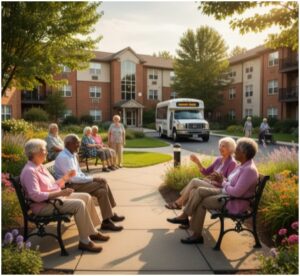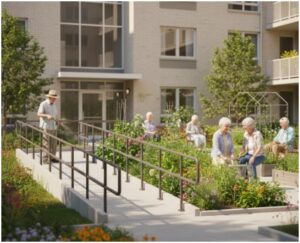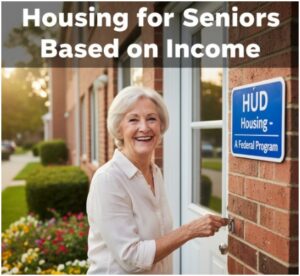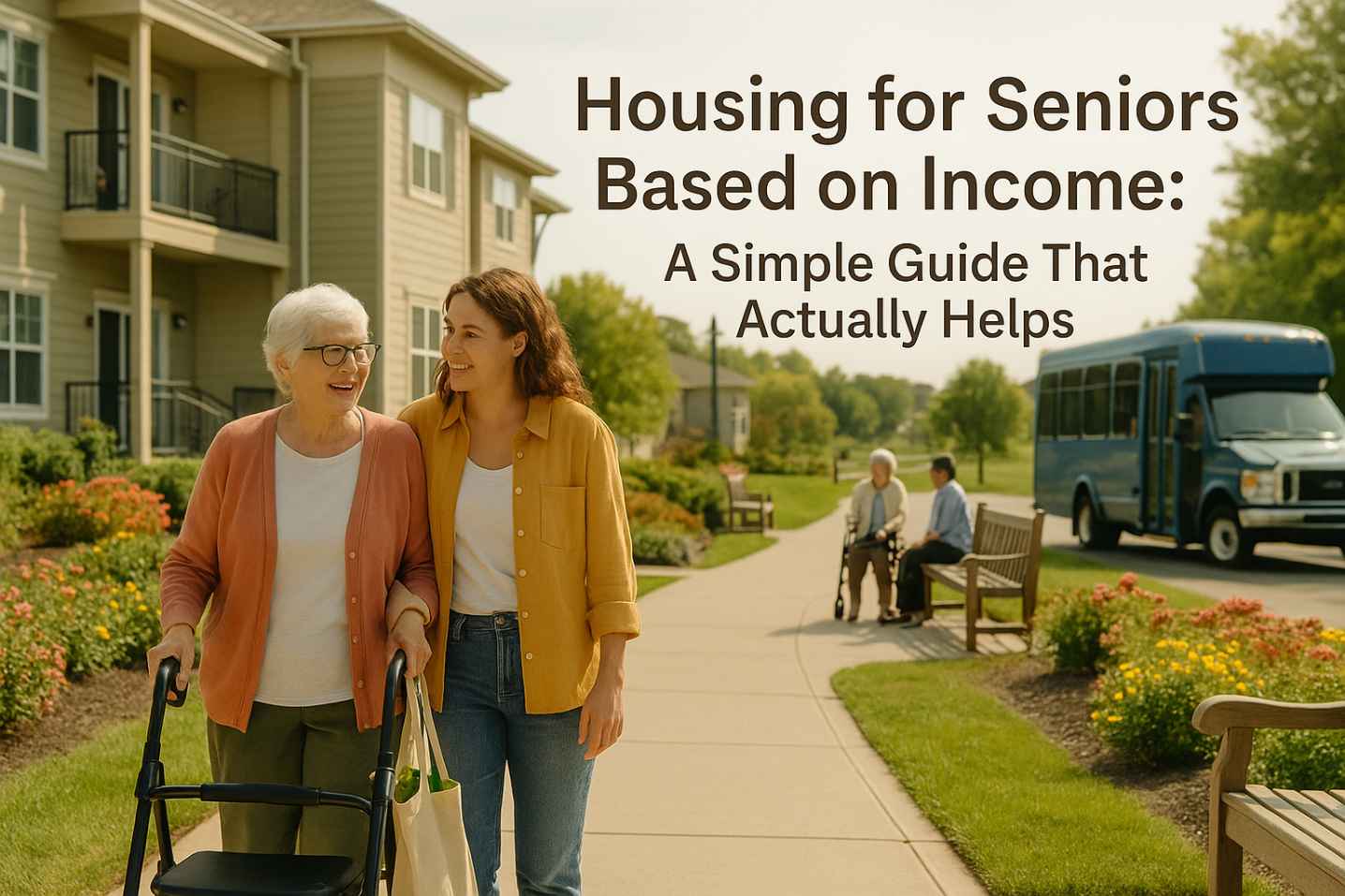I’ll be honest — when my aunt turned 65 and decided she was done mowing lawns and fixing leaky faucets, we both thought finding affordable housing for seniors based on income would be as easy as typing a few words into Google. Spoiler: it wasn’t.
We found ourselves tangled in acronyms like HUD and PHA, waiting lists that felt eternal, and forms longer than a CVS receipt. But here’s the thing — once we understood how these programs worked, everything changed.
She’s now living in a cozy one-bedroom with neighbors her age, a shuttle that takes her to the grocery store, and rent she can actually afford.
If you’re helping a parent, relative, or even yourself navigate this maze, you’re in the right place. I’ve rounded up everything I wish someone had told me — and I promise to keep it practical, fun, and totally free of government-jargon headaches.
What Exactly Is Housing for Seniors Based on Income?

At its core, housing for seniors based on income is about making sure older adults — usually 62 and up — can live comfortably without draining their savings.
Instead of paying market rent, seniors pay a percentage of their income (often around 30%), and federal or local programs cover the rest.
The U.S. Department of Housing and Urban Development (HUD) runs most of these programs, but they’re managed locally through Public Housing Agencies (PHAs).
That means your experience in Chicago might look different from your cousin’s in Phoenix, but the goal is the same: safe, affordable housing that respects seniors’ budgets and independence.
How Does Section 202 Supportive Housing Work for Seniors?

If your idea of retirement includes less stress and more support, Section 202 might be the dream ticket. This program is specifically for very low-income seniors aged 62 and older. Nonprofits get federal funds to build or renovate housing, and seniors pay about 30% of their adjusted income for rent.
What makes Section 202 special is the extra help that often comes with it. Many communities offer services like meal programs, transportation, or housekeeping — all designed to help residents live independently longer. My aunt, for example, gets a free weekly ride to her doctor’s appointments, which is a game-changer.
How to apply: Unlike other programs, you don’t go through a central office. Instead, you apply directly to the management of the Section 202 property you’re interested in. HUD’s apartment locator is your best friend here — use it to find options near you.
Can I Use Section 8 Vouchers for Senior Housing?

Absolutely — and this option is perfect if you want flexibility. The Housing Choice Voucher Program (Section 8) doesn’t tie you to a specific building. Instead, it gives you a voucher you can use for privately owned housing that meets program requirements.
Here’s how it works: you pay 30% of your income toward rent, and your local PHA pays the rest directly to the landlord.
That means you could live in a small apartment downtown, a duplex near your grandkids, or a quiet complex in the suburbs — as long as the property qualifies.
Heads-up: Waitlists for Section 8 are notoriously long, and some PHAs prioritize elderly applicants. Apply to multiple agencies if possible. The sooner you’re on the list, the sooner your voucher can come through.
What About Public Housing for Seniors?

Public housing is the most straightforward form of housing for seniors based on income. It’s owned and managed by local PHAs and available to low-income families, people with disabilities, and seniors. Rent is, once again, about 30% of your adjusted income.
The main difference here is that public housing doesn’t usually come with the supportive services offered in Section 202 communities. It’s best suited for seniors who are independent and don’t need daily assistance.
My neighbor’s mom, for example, loves her public housing apartment because it’s simple, central, and filled with people she’s known for years.
Who Qualifies for Income-Based Senior Housing?
Eligibility might vary slightly by program and location, but here’s the general breakdown:
| Requirement | What It Means |
| Age | Most programs require you to be 62+, though some senior apartments accept residents 55+. |
| Income | Your household income usually must be 50% or less of the Area Median Income (AMI). Some programs target 30% or less. |
| Citizenship | You must be a U.S. citizen or have eligible immigration status. |
Some programs may also consider disability status or veteran status, so it’s worth mentioning any relevant details when you apply.
How Do I Apply for Housing for Seniors Based on Income?
Here’s the part that feels like a treasure hunt — but I promise it’s doable if you take it step by step.
1. Contact Your Local Public Housing Agency (PHA)
Your PHA is your gateway to Section 8 vouchers and public housing options. You can find your local office using the directory on the HUD website. They’ll guide you through eligibility requirements, open waitlists, and application forms.
2. Search for Section 202 Properties
For supportive housing, you’ll need to contact property owners or managers directly. HUD’s apartment locator tool is the easiest way to find these properties. Remember, spots are limited, so apply to several communities if possible.
3. Use the Eldercare Locator
This free nationwide service (call 1-800-677-1116) connects seniors with local resources, including housing options. It’s a great way to get personalized help if you’re feeling overwhelmed by the process.
4. Talk to a HUD-Approved Housing Counselor
Housing counselors are trained to help you understand your options and complete your applications. They’re especially helpful if you’re applying for multiple programs or navigating complicated paperwork.
What Should I Expect After Applying?
I’ll be real with you — this is not a “submit today, move in tomorrow” situation. Housing for seniors based on income is in high demand, and waitlists can stretch for months or even years.
Some PHAs open their applications only once a year, sometimes for just a single day. That’s why it’s so important to apply early, apply often, and make sure every part of your application is complete. A single missing document can set you back months.
Patience is key here. My aunt waited almost a year for her Section 8 voucher, but she says it was worth every second. Once you’re approved, the peace of mind that comes with stable, affordable housing is unbeatable.
FAQs About Housing for Seniors Based on Income
1. Can someone under 62 qualify for income-based senior housing?
In most cases, no — programs like Section 202 and many senior apartments require at least one household member to be 62 or older.
However, some properties and age-restricted communities accept residents 55 and older, so it’s worth asking about specific age policies when applying.
2. How long are the waitlists for income-based senior housing?
Wait times vary wildly by location and program. In high-demand areas, waitlists for Section 8 vouchers can be several years.
Public housing waitlists might be shorter, but they still require patience. My tip? Apply to multiple programs and agencies to increase your chances of finding a spot sooner.
3. Are supportive services always included in senior housing?
Not always. Section 202 properties often include extras like transportation or meal assistance, but public housing typically does not.
Section 8 vouchers also don’t guarantee supportive services — you’re renting from a private landlord, so what’s included depends on the property.
4. Can I apply for more than one housing program at once?
Yes, and you absolutely should. There’s no rule against applying for Section 202, Section 8, and public housing simultaneously. Each has different wait times and requirements, and applying broadly gives you more options and better odds.
Wrapping It Up With a Roof Over Your Head
Here’s the truth: navigating housing for seniors based on income isn’t always easy. There’s paperwork, waiting, and a fair amount of patience required.
But once you get through it, the payoff is huge — stable rent, a safe community, and a home where you or your loved one can truly enjoy retirement.
If there’s one piece of advice I’d give, it’s this: start early. Even if you’re a few years away from needing it, getting on a waitlist now can save you headaches later.
And don’t be afraid to ask for help — from PHAs, housing counselors, or even a persistent niece who’s determined to crack the code (hi, that was me).
Affordable, comfortable senior living is possible — and now you know exactly where to start looking.










